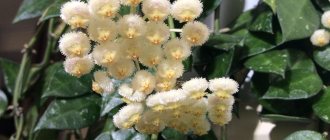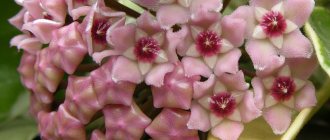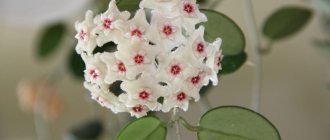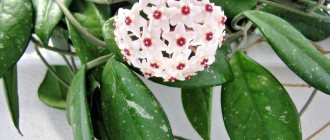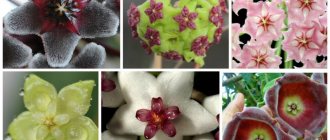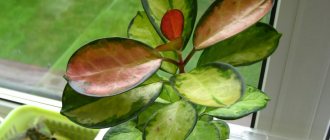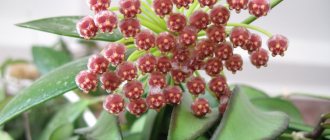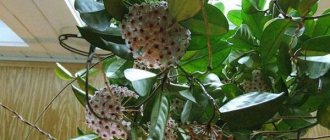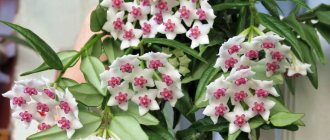Plants » Flowers
0
1329
Article rating
Kira Stoletova
The exotic flower Hoya belongs to the Lastovnevy family. It lives in the warm climate of Asia, Australia, America, India, and tropical islands. The plant was named after Thomas Hoy, an English gardener who was the first to study and grow different species in a greenhouse.
Hoya photo indoor photo
general characteristics
Hoya is classified as a vine and is also called wax ivy. It is capable of branching, climbing onto a support, although some species are bush-like.
Flowers and leaves are dense and shiny, as if made of wax or porcelain. The root system is superficial. Inflorescences are umbellate, with or without fragrance.
Indoor Hoya looks spectacular in any interior, which is another reason for growing it.
All types are different, but generally unpretentious - keeping them at home does not present any special problems. However, this exotic requires caution: in some sources, wax ivy is called a poisonous plant, so it should be kept away from children.
Popular types of tropical beauty hoya: their features and photos
Wax ivy, porcelain flower - these are also the names of this attractive succulent, which has firmly entered into human life as one of the most unpretentious ornamental plants. This evergreen miracle arrived in our country from the distant tropics. On the Pacific Islands, Australia and Polynesia, India and Madagascar, on the peaks of the Himalayan mountains and southeast Asia, more than 200 species of both powerful climbing vines with fragrant flowers and small low-growing shrubs grow.
Varieties
Hoya varieties are captivating in their diversity (there are more than 200), some of them are especially popular and widely distributed as house plants.
Carnosa
This is a long-known and widely popular variety. It has long curly stems and beautiful decorative leaves (green with silver spots). Delicate pink flowers with a red center are collected in hemispherical umbrellas.
Cultivars and subspecies: Argentia Picta, Variegata. cv. Tricolor, Krimson Queen, Susie Q, Gray Ghost or Gray Ghost, Holliana, Chuk, Krinkle, Stardust, etc.
Macrophylla
A vigorous vine with large leaves (up to 25 cm in length). The leaves are oval, with a sharp tip and visible veins. May have a light border or center. Inflorescences are spherical. The flowers are red and white with a pink crown and internal pubescence.
Varieties: Latifolia, Clandestina, Pot of Gold, Albomarginata, Snow Queen and others.
Obovata
A fast-growing vine with round, dense leaves. The leaves are green with a splash. The profusely blooming hoika forms umbrellas of 15-30 pubescent flowers. The corolla is white or pinkish, the middle is dark pink.
Caudate
Synonyms: Flagellate, Crassifolia. Hoyka with climbing stems and waxy oval leaves. There are silver splashes. The corollas of the flowers are creamy pink, with long “cilia”, the crown is red.
Publicyx
Cultivars: Royal Hawaiian Purple, Duck Red, Button Red, Pink Silver, Prince, etc.
A climbing vine with leathery leaves. There are 25-30 flowers collected in an umbrella. The color range ranges from soft pink to dark red (almost black). In the evenings it exudes a refined aroma.
Obscura
Options: IML 1003, Yellow, var. Longpedunculata, Variagata, hybrid form Rebecca. Dense epiphytic vine from the Philippines.
The leaves are dark green, glossy, oval-oblong with a “spout”. The flowers are pubescent, soft pink or pastel yellow, forming inflorescences of 20-30 pieces.
Walliniana ut-152
Lives in Malaysia and Borneo. A fast-growing and well-climbing variety with smooth leaves that change from green to burgundy in full sun. The flowers are white, with a yellow crown and red center, pubescent inside. Appear in inflorescences of 20-30 pieces.
Ruthie
A climbing plant with oval green leaves. A light vein is clearly visible on the leaf. The flowers are glossy, star-shaped, creamy yellow with a pink center.
Tam Dao
Large vine with dense leaves. The leaf is green, oval, slightly wavy, with a sharp tip. The flowers are collected in an umbellate inflorescence. The petals are white, the crown is yellow, the center is red.
Hoya flower indoor photo
Diptera
Bush hoya lives in Fiji. The flowers are collected in flat umbrellas. Depending on the subspecies, the flower may be yellow with a purple center or cream with a yellowish center. The leaves are oval, green in color (there are silvery spots on older leaves).
Hoya sp UT-033
A pretty vine with glossy leaves and a dense umbrella of flowers. In the sun, the leaves turn from green to purple. The flowers are small, cream-colored with a red center.
Affinis Hemsley
Grows in the Solomon Islands. Upright, but needs support. Leaves, stems and flowers are slightly pubescent. The leaves are bright green, oval, with a pointed tip. The flowers are pink or red, collected in a rounded umbrella.
Meredithii
Ground vine with branched and climbing stems. It has large original leaves: up to 30 cm in length, green, with a spectacular pattern of darker veins. Glossy flowers are collected in hemispherical umbrellas of 20-35 pieces. The petals are creamy yellow, the center is white, translucent.
Sabah
Variety - Beauty. A weaving hoyka with decorative dense leaves. Depending on the subspecies, the leaves have dark veins or silvery spots. The flowers are cream-colored, collected in small inflorescences.
Manipurensis
The following names are also in use: lantsangensis Tsiang et PT L, Micholitzia obcordata. The plant comes from China. The shoots reach 25-30 cm, the leaves are small (up to 3 cm in length), oval. The flowers are pubescent, red or yellow with an orange crown.
Scortechinii
Five-meter vine from Malaysia. The vines are thin, the leaves are oval with a pointed tip (up to 15 cm in length), green with purple veins. Flowers have petals curved back, spherical in shape. The petals are white, slightly lilac, the crown is creamy yellow, and the center is reddish.
Siaria or Siariae (Siariae)
Beautiful hoya from the Philippines. It has elongated narrow leaves with a glossy surface, dark green, with thin veins. The flowers are bell-shaped, pink or red, translucent, pubescent inside.
Wilbur or Wilbur (Wilbur Graves)
An original hoyka with very decorative leaves. The green leaves are literally “flooded” with silvery variegation. The flowers are white with a red center, collected in dense spherical umbrellas.
Patella
Epiphytic hoika with thread-like shoots. The leaves are green, oval, with a narrowed tip, pubescent below. Flowers grow in several pieces. The flower is cup-shaped, pink, with a bright crimson crown.
Lobby
Lives in India and Thailand. Bush hoyka with stems up to 1 m. Leaves are green, with rare light inclusions. The flowers are dark red (as if illuminated from within) with a white center and emit a pleasant aroma. The Cream variety has cream flowers.
Coriacea
Synonyms: Angustisepala, Mindanaensis. Hoyka with beautiful leathery leaves and lush umbrellas of flowers (from 30 to 75 pieces). Petals are yellow, curved back. The crown is a little lighter, the center is purple.
Germany
Large-leaved liana. The leaves are green with dark veins (up to 15 cm in length). The flowers are lemon, collected in umbrellas of 30-40 pieces.
Tsangi sp. DS-70
Lives in the Philippines. A liana with dense, velvety leaves – green with a darker border. A loose umbrella contains 10-15 flowers with a sweet aroma. The petals are red and curved back. The crown is reddish-orange.
Nicholsoniae
Synonym: Helvigiana. A common variety with bare vines and dense leaves. The leaves are green, but in the sun they take on a burgundy hue. Flowers are collected in umbrellas of 15-40 pieces. Depending on the subspecies, they are yellow, red, cream or greenish.
Balensis or Balaensis (Balaensis)
Epiphytic climbing vine with leathery leaves. The leaves are green, but may have silver or light splashes. Up to 50 flowers are collected in an umbrella. The corolla is yellowish, the crown is pink.
Lacunosa
There are many cultivars: Tove, Snow Caps, Eskimo, etc. Small-leaved vine with diamond-shaped leaves. The flowers are white with a nice pile, the middle is yellow. 10-20 pieces are collected in an umbrella. The aroma is pleasant and quite strong.
Phu Wua (Phu Wua or Phuwuaensis)
A climbing vine with glossy dark green leaves. The leaves are oval, with a sharp tip and a pronounced splash. The flowers are small, with a white corolla and a red center, collected in a flat umbrella.
Macgillivrayi
Hybrid form - Kaimuki. Large-flowered vine from Australia. It has glossy leaves (up to 18 cm in length), dark green with light specks. The flowers reach a diameter of 8 cm. The corollas are purple, the center is white.
Lithophytica
Lives in rocky areas. Hoyka has small dense leaves, dark green, sometimes with light specks. The flowers are white with a pink center, collected in umbrellas of 10-15 pieces. They have a weak aroma.
Magnifica
Epiphytic hoya with long lashes (3-4 m). The leaves are oval, dense, up to 20 cm. The flowers are large (5-9 cm in diameter), red and white. The aroma is reminiscent of gardenia.
Ciliata
Hoya is native to the Philippines. It has small leaves (up to 8 cm in length), dense, although thin, green, with short hairs. The flowers are up to 4 cm in diameter, star-shaped, with a musky aroma. The corolla is dark red, almost black. The crown is golden yellow.
Wiberg or Wibergiae
Epiphytic liana from the Philippine tropics. The leaves are dense, oval, dark green with a splash. The flowers are cream with a reddish center. The petals are pointed and curved back. The inside of the corolla is velvety.
Heuschkeliana or Heuschkeliana
Epiphytic creeping Hoya. The leaves are small (up to 5 cm in length), green, slightly curled down. Depending on the subspecies, the flowers are pink or yellow, collected in umbrellas of 3-7 pieces. In the evening they smell like caramel.
Vitiensis
The homeland of this hoya is the Fiji Islands. The leaves are smooth, oval, with a sharp tip and a depressed central vein, bright green, up to 12 cm in length. The flowers are flat, pink, with silvery pubescence and “curly” petals, and smell pleasant.
Finlansoni or Finlaysonii
An interesting variety with unusual, decorative leaves. The large (up to 20 cm in length) light green leaf is covered with a relief pattern of darker veins and a distinct border along the edges. Small creamy-white flowers are collected in spherical inflorescences.
Hoya care at home
Aldrichii
Australian hoika epiphyte. The leaves are oblong, dense, shiny, intensely green. The corollas of the flowers are white or slightly pinkish, the crowns are purple. They grow in spherical inflorescences of 20-40 pieces.
Bahoi
Quite a rare liana with beautiful decorative leaves. The leaves are large (up to 20 cm in length), glossy, dark green, with a well-defined splash. The shape is oval, with a sharp tip.
Moonshadow (Incrassata Moonshadow)
Liana-shaped hoika. The leaves are oval, green with veins and a variegated stripe in the center. Inflorescences are spherical. The corolla of flowers is creamy-lemon with red-brown edges. The crown is white, translucent. They emit a fresh aroma.
Quinquenervia
Liana with beautiful waxy leaves. The leaf is green, oval, with a slightly curved tip. Inflorescences are spherical. The flowers have a yellow corolla with delicate inner pubescence and a white crown.
Hoya IR-26
Compact bed. The leaves are round, green, with a pointed tip and a silvery splash. In bright sun the leaves turn red. The flowers are small, yellow-red.
Rotundiflora
Original hoya from Thailand. Its peculiarity is waxy, green leaves of an interesting rounded-rectangular shape with curved edges. The flowers are creamy white with a pinkish center.
Rosita or Rosita
An interesting hoyka with thin curly stems and small leaves. The leaves are decorated with a dark border and may turn red in the sun. The flowers are small, pink, collected in hemispherical loose inflorescences.
Fitchii or Fitchii
Beautiful hoyka from the Philippines. The leaves are bright green, leathery, with light veins. The flowers are waxy, soft apricot with a pink center, collected in hemispherical inflorescences.
Waymani or Waimani (Waymaniae)
A vine with strong stems native to Borneo. The leaves are large (up to 15 cm in length), with wavy edges, slightly rough, with reddish pigmentation. The flowers are orange-red, collected in inflorescences of 15-25 pieces.
Endauensis
A rare species native to Malaysia. It has thin bare stems, rounded leaves with a “spout”. The surface is shiny, the edges are slightly wavy. The flowers are green-purple, very small (4 mm in diameter).
Limonica or Schisandra (Limonica)
Compact Hoya. The leaves are medium sized (up to 8 cm in length). The flowers are white or cream with a red center. The shape is star-shaped, the petals are slightly bent back. Emit a light aroma in the evening.
Guning or Gunung Gading
Sometimes it is called Gooding - forming one word from two. Hoyka is originally from Borneo. It has beautiful bright green leaves with a dark vein pattern. The flowers are white and pink, collected in hemispherical inflorescences.
Joy
Epiphytic liana from Hawaii. The leaves are large (15-18 cm in length), green with a light silver splash. Inflorescences are hemispherical. The corolla of the flower is yellow-light green, the crown is pink.
Blashernaezii
Epiphytic liana with large oblong leaves (up to 20 cm). There is slight pubescence. The flowers are bell-shaped, soft yellow, glossy, translucent. Collected in a drooping umbrella inflorescence.
Calistophylla (Callistophylla)
This hoyka has light green leaves with visible veins. The flowers are small, with a reddish corolla and a white crown. The aroma is not for everyone.
Parasitica Lao
Synonym: Rigida. A fast-growing hoyka with climbing shoots. The leaves are glossy, oval, with a pointed tip, green with a splash, medium in size. The flowers are small (1 cm in diameter), with a white corolla and a carmine crown. 35-40 pieces are collected in an inflorescence. Smells nice.
Pictah
Liana with small diamond-shaped leaves. The flowers are small, collected in a miniature umbrella. The petals of the corolla are apricot-yellow, the center is reddish-orange.
Benguetensis
Hoya with climbing stems. The leaves are elongated and thick, green in color, but may turn red in the sun. The flowers are yellow-orange, with a purple center. Collected in umbrella inflorescences of 15-20 pieces.
Kenejiana
Lives in New Guinea. The vine has thin green oval-shaped leaves with a sharp tip. The flowers are golden yellow, collected in hemispherical umbrellas of 20-25 pieces. The Albomarginata variety has leaves with a white border.
Rintzi
Epiphytic liana with long vines (up to 10 m). The leaves are leathery, oval, bright green with specks. The flowers are white, sometimes with a cream crown and a pink center.
Hoya wax ivy photo
Patricia
An extremely beautiful hybrid variety. Green leaves turn red in bright sun. The flowers smell nice. They have a white corolla and a lavender-pink center.
Hoya sp. EPC-600
Epiphytic Hoya. The leaves are dark green and glossy, decorated with a beautiful silver splash. The flowers are star-shaped, with a cream corolla and a pink center.
Incurvula
A liana with light green leaves of oval or round shape. Small umbrellas are collected from 10-15 flowers. The corollas are creamy pink, the crown is greenish-red.
Archboldiana or Archiboldiana (Archboldiana)
Hoya with dark green leathery leaves (up to 15 cm in length). Umbrella inflorescences consist of 7-10 flowers. The shape of the flowers is bell-shaped, diameter is 4 cm. The corolla is white or pink, the crown is red.
Hoya ut 073
Hoyka with large decorative leaves - light green with darker veins forming a border and pattern. It blooms with pink or cream flowers with a bright center.
Forbesi or Forbesii (Forbesii)
Epiphytic liana with smooth leaves. The edges of the leaves are slightly curved. The umbrella contains up to 15 light green flowers with a yellow crown. Has no aroma.
Narcissiflora
Epiphytic hoika, blooming with small pale yellow flowers. Lives only in Kilimantan. It has thin oval leaves with a narrowed tip.
Soidaoensis
Small-leaved vine from Thailand. In the sun, the edges of the green leaves become purple. The flowers have a yellowish corolla with hairs, a transparent crown and a pink center.
Vitalina or Vitellina (Vitellina or Vitellinoides)
Epiphytic hoyka, blooming in spherical inflorescences. The leaves are fleshy, leathery, with a dark border. The corolla of the flower is dark beige, the crown is bright pink.
Biakensis or Biakensis (Biakensis)
The leaves of this plant are almost round and covered with a spectacular silvery splash. It blooms with small yellow flowers. Exudes a sweet aroma.
Hoya flower photo care at home
Gracilis
Hoyka has small oblong leaves with a sharp tip, without pronounced veins, but with silvery splashes. The flowers are red with a yellow center. Collected in inflorescences of 10-20 pieces.
Beautiful or Bella (Bella)
Small-leaved vine from India and Thailand. The leaves are diamond-shaped, narrow, green. The flowers are truly beautiful: with a snow-white star-shaped corolla and a bright purple crown. Umbrellas are small and flat. Smells like vanilla.
Pachyclada
Thick-stemmed hoyka with pubescent leaves and stems. The leaves are leathery, green, round with a “spout”. The flowers are white, cream or yellowish. They exude a refined “perfume” aroma.
South or Australis (Australis)
Varieties: Lisa. Grows up to 3-10 m. The leaves are oval or rounded with a heart-shaped base and a sharp tip. The flowers are white or cream with a red spot under the crown. They emit a sweetish aroma.
Polyneura Broget
Lives in the Himalayas. The bushy vine grows up to 3-4 m. The leaves are diamond-shaped, with an interesting pattern of bluish veins. The corolla of flowers is white, the center is red.
Linear or Linearis
Epiphytic hoika with lashes up to 6m. The leaves are narrow, gray-green. The flowers are star-shaped, with a white corolla and a yellow center. They emit a vanilla aroma.
Globulosa
Synonym: Villosa Vietnam. Hairy hoya with large, veiny leaves. The edges are slightly wavy. Umbrellas are spherical and consist of white or cream flowers.
Imperialis
A vigorous growing epiphyte with large flowers. The leaves are leathery, fleshy, oval, with a longitudinal vein. The diameter of the flower is 6 cm. Hoya can bloom yellow, pinkish or greenish.
Meliflua
The large-leaved vine grows up to 4 m. The stems are thick and curly. Inflorescences are hemispherical, with 15-20 flowers. The corolla is pink, the central part is red.
Elliptica
Subspecies: Elliptica Splash . The leaves are medium in size, green with light veins (may have a splash). The flowers are white, quite large with a reddish center. They emit a light aroma.
Serpens
The small-leaved hoika lives in India, Australia, and Nepal. The leaves are gray-green, rounded, iridescent. The flowers are pubescent, pastel greenish, with a pleasant aroma.
Lasiantha
Bushy liana. The leaves are large, leathery, green-gray. Flowers are collected in drooping umbrellas. The corolla is bright orange, the crown is purple, with pubescence.
Griffiti
Rare view. The leaves of the vine are green, elongated, glossy with silver splashes. The flowers are milky white, up to 3 cm in diameter. Some varieties can bloom pink.
Buotti
A liana with thin climbing stems and succulent pointed leaves. Flowers are collected in umbrellas of 15-30 pieces. The corolla is lemon-colored, with beautiful pubescence. The inner crown is red.
Pandurata
Originally from China. Hoyka has elongated leaves with a silky sheen. The stems grow up to 1 m. The flowers are orange, with a red center.
David Cumingii
Liana from the Philippines. It has slightly narrowed, dark green leaves with a dark border. The umbrella contains 15-20 flowers with a diameter of up to 1 cm. The corollas are red, the middle is orange.
Mindorensis
Varieties: Superbra, Erytrostemma. Hoyka with curly stems and leathery, green leaves (they turn red in the sun). The corolla of flowers is red or white, beautifully pubescent. The crown is orange or reddish.
Megalaster
Hoyka with large flowers of unusual shape. In diameter - 6 cm. The flowers are dark red with petals directed forward. They emit a pleasant aroma.
Flores Island sp. UT 039
Hoyka with beautiful leaves that turn red in the sun. The inflorescences are bright pink, collected from 10-20 flowers. Emit a light vanilla aroma.
Parviflora
Cute hoyka from Thailand. It has thin curly stems and narrow dark green leaves. The flowers have a pale pink corolla and pubescence. They emit a perfume aroma.
Danumensis
Bush-like hoya with small dark green leaves. The flowers are white, bell-shaped with a flat corolla. There is pubescence.
Jennifer
An interesting variety is the cultivar Incrassata. A liana with bright green leaves decorated with a pattern of darker veins. Inflorescences are hemispherical. The flowers are creamy white with purple tips.
Ariadna
Spectacular large-flowered vine. The leaves are dark green, shiny with a longitudinal vein. The flowers are star-shaped, bright orange. The middle is reddish. Exudes a subtle musky aroma.
Lauterbachii
A vigorous vine with slight pubescence. The leaves are oval, bright green. In inflorescences there are 4-7 flowers. Diameter – 7 cm. Shape – bell-shaped. The color of the corolla is red or pink, the center is light.
Flavida
Lives in the Solomon Islands. The stems are curly. The leaves are medium sized, light green, with a central vein. Flowers – orange, pubescent; center is red.
Funga or Fungi (Fungii)
A fast-growing climbing vine native to southern China. The leaves are rounded, with a beautiful pattern of dark veins. Dense spherical umbrellas contain 50-60 flowers. The corollas are white or pinkish.
Chicken Farm
Originally from Borneo. The first specimen was found near the chicken coop (which is where the name comes from). The leaves are hard, shiny, and silvery speckled. The corollas of the flowers are yellow with reddish tips, the crown is white.
Cystiantha
An interesting variety with beautiful dark green leaves covered with a silvery splash. The flowers are bell-shaped and beige. Collected in almost flat inflorescences.
Elle
Compact bed. The leaves are dark green, oval, with sharp tips and a beautiful splash. They may turn red under the sun. It blooms with fluffy pink flowers with a yellow center.
Coronaria
Liana with thick, velvety pubescent leaves. The flowers are large, star-shaped. The corolla is creamy, the center is light green and pink.
Wayetii
A variety with elongated, narrow leaves decorated with a dark border. The inflorescences are lush umbrellas. The flowers are pubescent, purple in color with a dark purple center.
Albiflora
A very rare species from New Guinea. Its peculiarity is snow-white glossy flowers. The leaves are oval, with a sharp tip and visible veins.
Onychoides
Lives in New Guinea. The leaves are green, lanceolate-oval, with a clear longitudinal vein. Flowers - with sharp petals, dark wine color. They grow in small inflorescences of 4-7 pieces.
Thompsoni or Tomsoni (Thomsonii)
Grows in Tibet, India and China. A pretty hoya with splashy, grey-green leaves. The flowers are snow-white with a pale yellow center. They are collected in inflorescences of 20-30 pieces and smell like jasmine.
Sigilatis
Liana with thin branched stems. The leaves are elliptical, with a sharp tip, with silvery spots. The flowers are pinkish, with a pale yellow center.
Sunrise
Fast growing Hoya. The leaves are green with silver specks. In bright sun they turn purple. The flowers are small, yellow or pinkish, collected in flat umbels.
Cumingiana
Shrub hoyka. The leaves are oval, green, smooth. Flowers are collected in inflorescences of 10-20 pieces. The corolla with pointed petals is light green. The inner crown is red-violet.
Kalimantan
Beautiful variegated hoya. The leaves are large, bright green with dark patterns and veins. The inflorescences are spherical. The flowers are cream with purple tips.
Kentiana
Liana with narrow pointed leaves. Blooms almost all year round. Inflorescences are small umbrellas with purple flowers. The centers are yellow.
How to propagate hoya at home
Acute EPC-997
Synonym: Verticillata. Liana with a beautiful pinkish splash on young leaves. Mature foliage turns dark green. The flowers are white with a red or yellow center.
Rangsan
Hoyka with very decorative leaves and flowering. The leaves are oval, slightly elongated, with a sharp tip and a splash. The flowers are soft pink, glossy, seem translucent, like lenses.
Denissi
A lush epiphyte native to the Solomon Islands. Hoya has dark green, hard leaves with a narrowed end and beautiful veining. The flowers are bell-shaped, pink, collected in inflorescences of 10-15 pieces.
Clemensiorum
A vigorous vine with large leaves (up to 40 cm in length). The leaves are dark green with a pattern of veins, and in the sun they turn reddish. The corolla of the flower is brown, the crown is yellow. They smell like musk and oranges.
Diversifolia
Hoya with leathery, rather large leaves. Flowers of 15-20 pieces are collected in umbrellas. The corollas are pink, the middle is darker.
Calycina
Lives in Indonesia and New Guinea. Long, pubescent vine. The flowers are cup-shaped, but then open like stars. The petals are white, under the crown there is a purple-red spot.
Pentaphlebia
Philippine vine with climbing stems. The leaves are round with a “nose”, green, shiny. The flowers are white with a yellowish center.
Michelle
Hybrid form of Hoyek Akuta and Laos. The leaves are oval, dark green with a splash, with a curved tip. The flowers are small, creamy white.
Platycaulis
Shrub hoya. The leaves are green, smooth, and medium in size. The flowers are collected in flat inflorescences of 10 pieces. The corolla is light green, the crown is yellow.
Shepherdi or Shepherdi
Lives in the Himalayas. The leaves are narrow, drooping, green. Flowers are white or pale pink, collected in 5-15 pieces. There is a hybrid Minibelle from crossing with Hoya Carnosa.
Cystianta
Synonym: Campanulata. An interesting variety with lush inflorescences. The leaves are medium sized, thin, smooth, green. The flowers are waxy and bell-shaped. White or slightly pinkish.
Paziae
Bushy liana. The leaves are oval, with a narrowed tip, green, shiny. The flowers are white, with a red center.
Sarawak
A plant with large leaves with wavy edges. The veins and silvery splashes are clearly visible on the leaves. Under the bright sun they turn red. The flowers are soft pink.
Erythrina
Subspecies: Cameron Island. Liana with thin curly stems. The leaves are smooth, green, with veins, and turn red in the sun. The flowers are collected in inflorescences and beautifully pubescent. The corolla is white with an orange tint, the center is pinkish.
Krohniana
Small-leaved hoika from the Philippines. The leaves are small, green (up to 4 cm long). The flowers are white or cream with a yellow center.
Ilagiorum
Climbing epiphytic hoika. The leaves are bright green, leathery, smooth, with veins. The flowers are collected in inflorescences of 20-35 pieces. The corolla is reddish-orange, the crown is pink.
Hoya varieties with names and photos
Teneba
A spectacular climbing vine with large oblong leaves. The leaves are green, but quickly turn red in the sun. They have visible veins. The flowers are vanilla yellow with an orange center.
Deykei
An interesting variety with heart-shaped leaves. The leaves are dense, green with small splashes and dark veins. The flowers are creamy white and smell musky.
Mitrata
A curly hoika with a slow growth rate. The leaves are green, with splashes, of two shapes: convex and concave. The flowers are cream or white, with a red spot under the inner crown.
Praetorii
Original variety from Indonesia. Bush hoya. The leaves are green, large (up to 20 cm in length). The orange corolla of the flower is bent back and beautifully pubescent around the crown. The center is wine beige.
Kanyakumariana
Epiphytic liana with interesting leaves - heart-shaped. The leaves are small, bluish, with wavy edges. The pubescent corolla is creamy white, the crown is red.
Louis (Lyi)
Subspecies: Burma. Lithophytic winter-hardy hoya. The leaves are oval, dark green, pubescent. Inflorescences are white or pinkish. The center of the flower is purple or yellow.
Longifolia
A vigorous vine with long narrow leaves. The inflorescence is umbellate and loose. The flowers are white, beautifully pubescent, with a light yellow center.
Cutis porcelana
New among the Hoyek. Epiphytic liana with thin shoots and green leathery leaves. The flowers are shiny, like porcelain. The corolla is dark beige, the center is purple.
Mirabilis
Epiphytic liana from Thailand. The leaves are lanceolate, dark green, with silver specks, slightly wavy along the edges. The flowers are pubescent, light green-yellow.
Viola
Hoyka with oval leaves and spherical inflorescences. The leaves are shiny, green, with visible veins and a curved tip. The flowers are small, creamy white, with a darker center.
Glabra
A vigorous vine from Borneo. The leaves are oval, bright green, with thin light veins. The flowers are collected in spherical inflorescences. The corolla and crown are pink, the center is yellow.
Cagayanensis
A fast-growing vine with emerald silky leaves. The edges are slightly curved down. White-yellow pubescent flowers are collected in spherical inflorescences. Exudes a light citrus aroma.
Kurtisii
Small-leaved compact vine. The leaves are small, grey-green, heart-shaped, with silvery splashes. The inflorescences are large. The corolla of the flower is olive, the crown is red.
Imbricata
A climbing vine with thin stems. The leaves are green with a silvery splash, closely pressed to the trunk, like tiles. The flowers are pubescent, yellow with a white crown.
Perak
Hoyka with large and shiny embossed leaves, with silvery splashes. Depressed dark veins create a spectacular pattern. The inflorescences are spherical, collected from cream flowers. Exudes ginger aroma.
Inflata
Hoyka with original flowers in the shape of bells. The leaves are dark green, matte, with a narrowed tip. The inflorescence contains 2-12 yellowish flowers, similar to lilies of the valley.
Purchase and adaptation
Adult hoya can be bought in special stores, but not every variety is easy to find. Many collectors or hobbyists sell cuttings for rooting via the Internet (gardening communities, forums, VK, ad sites, etc.). They offer not only popular, but also rare species (the price for cuttings is much lower than for rooted hoyka).
After purchasing, the vine (or cuttings) should be placed for two to three weeks separately from other plants. She is regularly examined for signs of illness. At this time, hoya cannot be trimmed, replanted, or fed.
Necessary growing conditions
How to root hoya from cuttings
- Hoya prefers bright, but diffused sunlight - the flowering process directly depends on this: if there is insufficient lighting, the vine will not bloom. It should be placed closer to the window, and in winter it should be artificially illuminated.
- The optimal temperature is 20-22°C. It should not fall below 15 °C (for some species - up to 10 °C).
- Humidity is moderate. In dry times, spraying is useful. A warm bath is sometimes used to make the hoyka bloom.
Landing rules
Full growth and lush flowering of this variety depends on the substrate and habitat. The soil used is light, loose and fertile. Several ingredients are mixed - turf soil, coarse sand, peat and humus in a ratio of 2:1:1:1.
For planting, you can take ready-made store-bought soil intended for ornamental flowering plants.
Before placing it in the pot, it is calcined in the oven for half an hour at a temperature of 100°C, poured with boiling water, a solution of fungicide or potassium permanganate. This treatment will help destroy all pathogenic microflora.
The hoya should be placed in a warm place with diffused daylight - a window on the south or southwest side is suitable.
If necessary, during lunch hours the plant is shaded from direct sunlight. When kept on a north window, additional lighting with a lamp will be required.
Care
Regular care will ensure abundant flowering and prevent diseases. Successful cultivation requires proper watering and fertilizing, pruning, and replanting into a larger pot (not too often).
Caring for a vine is not difficult, but some features must be taken into account.
Watering
Liana loves moisture, but does not tolerate waterlogging. The flowerpot should have a drainage layer and holes from which excess water flows into the pan. Then it is poured out. Before the next watering, the substrate needs to dry out. In hot weather, water 2-3 times a week with settled water (slightly warmer than room temperature), in winter - much less often, as needed.
Feeding
Hoya is fed with a complex of minerals, using a composition for succulents or orchids. I reduce the dosage of the substance for the volume of water specified in the instructions by half. Fertilizing is applied 3-6 times a season (summer and spring).
Trimming
Under natural conditions, pruning is not necessary, but at home, the growth of the vine must be controlled. Cut parts of the stems can be used as cuttings to propagate hoyka. Faded flower stalks are not cut off.
Transfer
Liana does not like transplanting too much and blooms better in a small pot. But if the roots have already entwined the soil and are sticking out of the drainage holes, it’s time to replant. Usually the procedure is carried out once every 5-6 years. Every year you can change the top layer of soil in the flowerpot.
Different periods: flowering - dormancy
Wax ivy begins to bloom in summer.
To stimulate the flowering process, in May and September it is necessary to dip the flower in water preheated to thirty degrees for several hours.
After this, the substrate is thoroughly dried. If “bathing” the entire plant is performed, the procedure time should be reduced to half an hour.
During the cold season, the plant should be given the opportunity to “rest”. A period of dormancy is indicated by a slowdown in the growth of the vine. As a rule, this is observed when daylight hours decrease.
In winter, in the plant storage area, it is necessary to reduce the temperature, reduce the amount of watering and temporarily abandon fertilizers.
A lack of moisture during the cold season contributes to more abundant flowering of hoya.
Reproduction
The most popular way to propagate hoya at home is using cuttings. On the cut section of the stem there should be a node with two leaves (you need to cut it 2 cm lower).
The cuttings must be rooted in water or directly in the ground. The last option is necessary for species with woody shoots. For rooting, it is better to use not soil, but a substrate made of expanded clay, sphagnum and peat.
Theoretically, the flower can be propagated by sowing seeds, but it is very difficult to get them at home, and buying them is also not easy.
Types of plants with beautiful leaves
Perhaps all types of hoya have beautiful leaves. Houseplants may have tri-colored, glossy, curled foliage. Several plants are distinguished by their unusualness and beauty:
- Kerry. Has unusual heart-shaped leaves;
- Hoya variegata. Leaves with cream edging;
- fleshy - the most common hoya among gardeners. The leaves are glossy, often speckled. Large and really meaty.
All hoyas are beautiful in their own way. They braid the frame well. It should be remembered that only young shoots of the plant can be directed. Then they harden and no longer respond to the direction of growth. If the growth of such a plant is left to chance, then the shoots will crawl into any crack found next to the flower pot.
Note! For some reason, it has long been believed that hoya should not be kept in the house. Supposedly she drives men away. There is also a sign that hoya in a rich man’s house means ruin, but these are just groundless signs that do not come true.
Diseases and pests
| Problem | Symptoms | Prevention | Control measures |
| Shchitovka | Pest insects look like dark brown bumps. | Proper care and maintenance conditions: watering, fertilizing, pruning. Frequent spraying of hoya and shower procedures, regular airing of the room, quarantine for new plants. | Wash the hoyka with tar soap. Remove plaques with a delicate brush. If pests are not removed, treat with Fitoverm. |
| Aphid | Small light green bugs. The leaves turn yellow, dry, and curl. | Cut off affected leaves and wash with soapy water. In case of severe pest infestation, use insecticides (Intavir, Fas, Karate). | |
| Whitefly | The appearance of larvae and white insects with wings (they multiply quickly). Shiny coating on leaves and sooty fungus. | Wash the Hoya with soap, water and alcohol. Hang sticky traps and collect caterpillars by hand. Change the top layer of soil in the pot. In serious cases, use Actellik or Confidor. | |
| Root and stem rot | Wax ivy does not grow. Dark softened areas appear on the stems. The leaves wither and fall off. | Avoid overwatering. Disinfect the flowerpot, drainage materials, and tools when replanting. Disinfect sections and |

